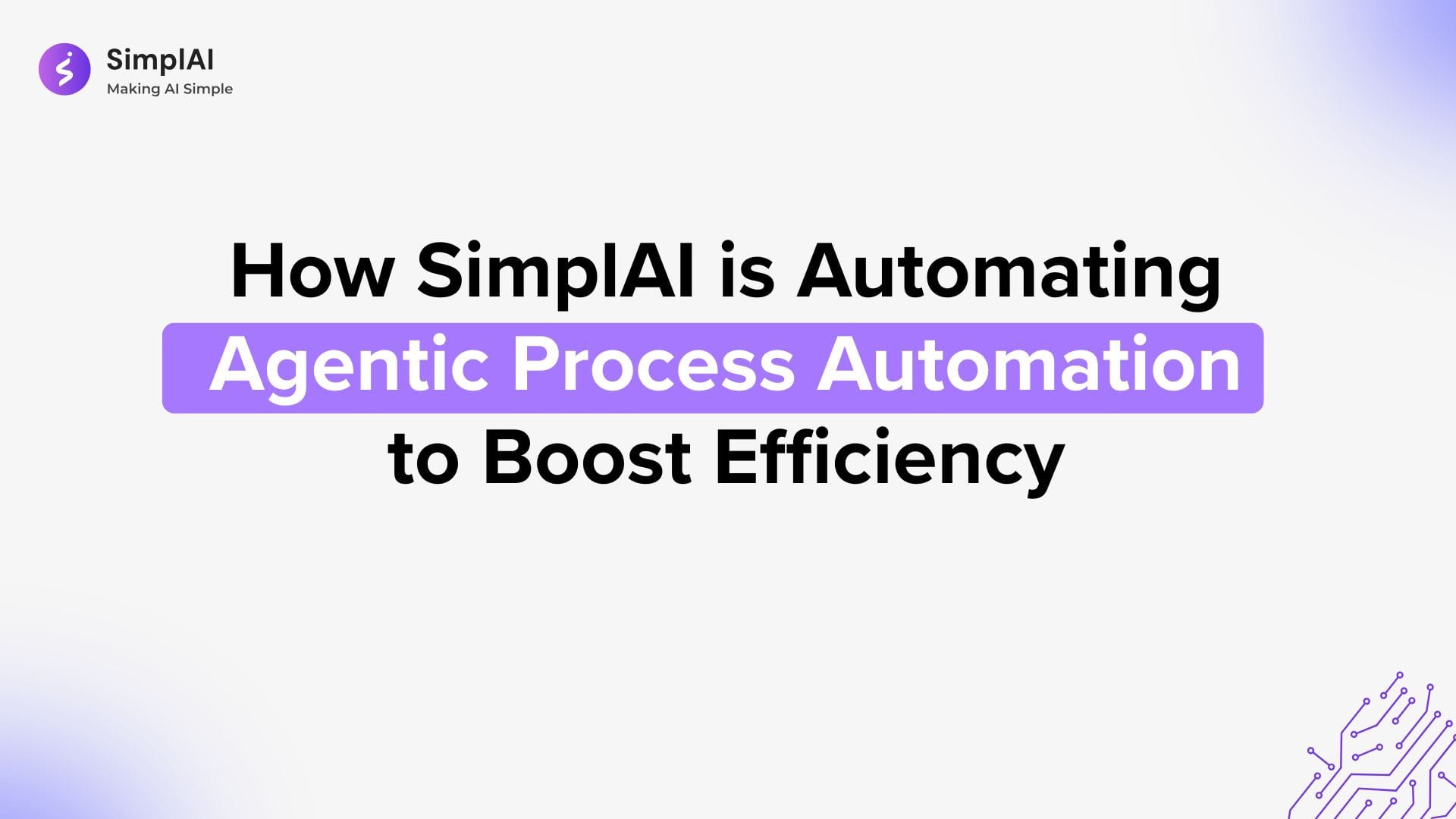How SimplAI is Automating Agentic Process Automation to Boost Efficiency

In today’s fast-paced enterprise landscape, rigid, rule-based automation too often crumbles under complexity. SimplAI’s Agentic Process Automation (APA) changes the game by empowering businesses to assemble intelligent, multi-step workflows driven by autonomous AI agents. These agents think, decide, and adapt in real time—eliminating manual bottlenecks, minimizing errors, and accelerating outcomes across industries.
Table of Contents
- What is Agentic Process Automation?
- Why Traditional Automation Falls Short
- What Makes SimplAI Different?
- How SimplAI’s Agentic Automation Works
- Use Cases Across Industries
- Key Capabilities That Power Efficiency
- Building Trustworthy Automations
- Technical Advantages for Enterprises
- Conclusion / TL;DR
1. What is Agentic Process Automation?
Agentic Process Automation (APA) moves beyond static scripts and triggered events. Instead of simply following hard-coded rules, APA relies on autonomous AI agents that can:
- Understand intent—interpreting tasks described in natural language.
- Reason—breaking goals into actionable steps.
- Act—interacting with systems, retrieving data, and executing decisions.
- Adapt—learning from outcomes and handling unexpected conditions.
With APA, workflows are no longer brittle chains of if-then statements. They become living processes that adjust on the fly—perfect for environments where every case can look different.
2. Why Traditional Automation Falls Short
Enterprises have leaned on Robotic Process Automation (RPA) and other tools for years, but these approaches struggle when:
- Rules change frequently. A minor tweak in an invoice layout or compliance checklist breaks the entire process.
- Data is unstructured. PDFs, emails, images or free-text fields stump rigid parsers.
- Integrations are siloed. Each API, database, or portal requires custom connectors and maintenance.
- Logic is static. Without learning, scripts can’t improve or adapt to new scenarios.
Over time, these limitations translate into mounting tech debt, wasted hours firefighting, and customer friction when processes stall or fail.
3. What Makes SimplAI Different?
SimplAI’s APA platform overcomes these hurdles by combining:
- Intelligent Agents. Each agent is powered by large language models (LLMs) that reason, retrieve knowledge, invoke tools, and self-correct.
- Agent Chaining. Agents collaborate—passing context, delegating sub-tasks, and orchestrating end-to-end workflows.
- Enterprise Connectors. With 300+ out-of-the-box integrations, SimplAI natively plugs into CRMs, ERPs, HR systems, document stores, and more.
- No-Code Builder. A visual, drag-and-drop interface lets business users design, test, and launch workflows—no developers needed.
- Built-in Observability. Every action, decision, and data point is traced: latency, success rates, input/output, confidence scores, and more.
Together, these differentiators mean you build resilient automations that evolve, not brittle bots you constantly babysit.
4. How SimplAI’s Agentic Automation Works
Step 1: Intelligent Decision Making
Users describe a task in plain language—e.g., “Validate this contract, extract key clauses, flag missing signatures.” An APA agent interprets the request, retrieves relevant templates or rules, and plans the sequence of actions needed to fulfill it.
Step 2: Process Workflow Automation
In SimplAI’s visual builder, each node represents an agentic action:
- Parse Invoice
- Retrieve Customer Record
- Summarize Risk Profile
- Send for Approval
Agents move dynamically from node to node—branching on conditions (e.g., low confidence, missing data), looping when needed, or escalating to a human.
Step 3: Guardrails and Reliability
To ensure trust, SimplAI applies layered safeguards:
- Source Verification with citations for every extracted fact.
- Confidence Thresholds to trigger retries or human review.
- Human-in-the-Loop options at any step.
- Configurable Fallbacks & Retry Logic to handle transient failures.
Step 4: Deployment and Monitoring
Once designed, workflows deploy in minutes—either on SimplAI Cloud or your private environment. Built-in dashboards surface:
- Latency & Throughput metrics
- Success vs. Error Rates
- Trace Logs showing every API call and LLM prompt/response
- Evaluation Metrics like precision, recall, drift detection
This visibility makes debugging and optimization a breeze.
5. Use Cases Across Industries
Healthcare
- Automated Clinical Documentation: Transcribe and summarize doctor-patient dialogues into structured records.
- Prior Authorization: Validate insurance data, pre-fill forms, and route for approvals.
- Denial Management: Extract root causes from claim rejections and recommend appeals.
Financial Services
- Credit Risk Assessments: Parse financial statements, compute ratios, and generate risk summaries.
- Loan Origination: Automate intake, pre-fill applications, and conduct AUS checks.
- Fraud Detection: Analyze transaction patterns and flag anomalies in real time.
Insurance
- Claim Adjudication: Auto-verify submitted documents, apply payout rules, and update statuses.
- Underwriting: Ingest KYC, credit reports, and generate comprehensive risk profiles.
- Policy Issuance: Draft, validate, and distribute policies with minimal manual effort.
Legal & Research
- Contract Clause Detection: Scan large archives for specific legal language.
- Summarization: Convert dense legalese into clear, human-readable briefs.
- Compliance Checks: Cross-reference up-to-date regulations against agreements.
Media & Telecom
- Content Moderation: Auto-detect and flag sensitive or prohibited material.
- Metadata Tagging: Apply intelligent labels to audio, video, and articles for downstream search.
- Customer Support: Orchestrate multi-step issue resolution via virtual agents.
6. Key Capabilities That Power Efficiency
- Agentic Workflow Builder
- Drag-and-drop nodes, conditional branching, context-passing.
- Document Processing & Extraction
- Multilingual OCR, entity recognition, summarization, classification.
- 300+ Data Connectors
- Real-time sync with CRMs, ERPs, HRMs; batch uploads; webhooks.
- Multi-Agent Systems
- Sub-agents for specialized tasks; autonomous coordination.
- Secure & Scalable Deployments
- SOC2/ISO 27001 compliance, hybrid or cloud, role-based access.
- Guardrails & Evaluations
- Trace logs, A/B testing, citation tracking, benchmark comparisons.
7. Building Trustworthy Automations
Trust is nonnegotiable in enterprise automation. SimplAI ensures it by:
- Citation & Source Tracking: Every insight links back to its origin.
- Human Approval Gates: Insert checkpoints where needed.
- Evaluation Framework: Continuously measure performance against ground truth.
- Version Control: Roll back or test new logic in isolated environments before full roll-out.
- Governance: Fine-grain permissions and approval policies keep sensitive flows locked down.
8. Technical Advantages for Enterprises
- High Throughput & Low Latency
Millions of parallel requests with <1 s responses via streaming inference and caching. - Flexible Deployment
SimplAI Cloud, AWS, Azure, GCP, on-premises, or edge-compatible for real-time, offline scenarios. - API-First SDKs
Comprehensive REST APIs, webhooks, and mobile SDKs for seamless embedding. - Observability Integrations
Native hooks for Prometheus, Grafana, and custom monitoring pipelines. - Scalable Architecture
Horizontal scaling, optimized memory usage, and node-level tuning handle peak loads effortlessly.
9. Conclusion
Agentic Process Automation represents the next frontier in enterprise efficiency—combining AI reasoning, dynamic workflows, and robust governance. With SimplAI, you get:
- Resilient Automations that adapt in real time.
- Speed to Value via no-code visual tooling.
- Enterprise-Grade Security & Compliance.
- Full Transparency through built-in observability.
Ready to eliminate manual bottlenecks, reduce errors, and scale confidently? 👉 See SimplAI in action with a personalized demo: https://simplai.ai/request-demo

